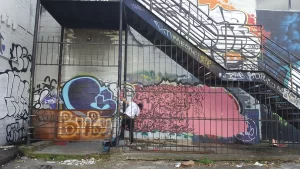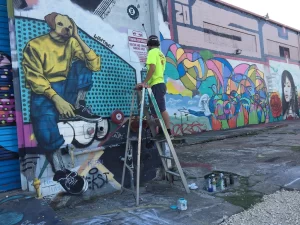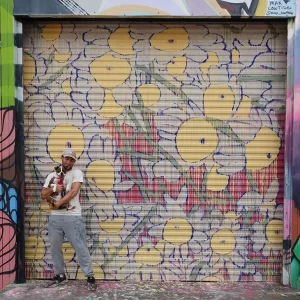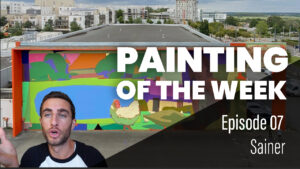Does the demolition of Graffiti Park mark the end of an era for Houston Public Art?
Short answer: yes, probably.
Honestly, I’m surprised it took them this long. And by them, I mean the City of Houston or whatever subdivision of the city (department of transportation?) received the contract. Whatever municipal department it is, my sense is that they probably have a handful of unfinished projects currently stagnating all over the city that they should attend to too.
Imagine having 10,000 incomplete commissions in your studio (all of which you’re obligated to complete), and then you say yes to another one. Some version of that is surely what is happening here; however, I lack the bureaucrat-speak, nuance, and frankly, the personal investment in this city to care to learn more. Nevertheless, someone is getting paid.
The point is:
The Writing was on the Wall.
And everybody knew it. For the last few years, but especially in the last few months, many of the conversations I had with both artists and passersby at Houston Graffiti Park were centered around acknowledgements of the impending conclusion to this public art haven.
That acknowledgement also fostered a sort of reverence and appreciation for Graffiti Park in a way that unified people, much like how the art did. This one square block was a true anarchic refuge in a city obsessed with rules, regulations, right angles, and beige colored walls.
I mean, c’mon.
Can people have one true space to express themselves? One where you don’t need approval from the neighborhood HOA to change the color of your front door, or a permit to shoot a music video while taking a colorful graduation photo?
Nope.

The Uniting Power of Art.
That was my ultimate take-away from participating and experiencing Houston Graffiti Park after all these years. A lot of the paintings were bad, some were really bad, but what always impressed me was that the people who enjoyed the space didn’t care. All types of people: Houstonians, out-of-towners, really every single demographic of person, would come visit the park and take photos in front of the colorful walls.
To witness this phenomenon for years served as a concrete reminder of the power of art to unite. The murals really did bring all types of people out, and they didn’t really seem to care about the quality of the work either.
As an opinionated art snob from the East Coast, I always found that detail to be very interesting.

My First time painting at Houston Graffiti Park…
…was as soon as I first moved to Houston in 2017. I hadn’t developed my studio painting or oil painting practice, and I was hopelessly obsessed with painting walls, murals, and illegal murals (graffiti?) because I didn’t have any other painting outlets at the time. I would ride my bicycle around the city (As my readers know, I still ride my bicycle around to paint), looking for spots. Needless to say, when I saw Houston Graffiti Park for the first time, I knew I would paint there and probably went back that same week to do so.
I don’t even think it was called Houston Graffiti Park yet; it was mostly referred to as the Meridian, and you could still go in the building.
I didn’t know any painters in Houston at the time and a local muralist who saw me painting (whose name I will not name) approached and told me that some crew held down that section of the wall (the North facing side) and that I was going to get my ass beat for painting there.
“Okay, thanks dude, I’m already halfway done with this piece.”
I didn’t care, I finished my piece. The ultimate irony, however, was that I ended up becoming friends with “that crew” of painters years later and would continue painting that same north-facing side for almost a decade.

My Second, Third, and Fourth Times Painting
These were slightly less memorable, probably between the years 2019-2022, and not worth spilling too much digital ink over. At one point, I was fixated on painting dog heads on human bodies (don’t worry, this was a short-lived phase). I also remember painting a composition on the far right-hand side of two teens in some abstracted city-scape environment.
I can’t find a picture of that painting, and I’m very okay with that.
The point is that this was a place to experiment, to explore, and to push creative limits without any of the stresses and pressures that often come with painting in the urban environment. Houston’s Graffiti Park was not the most formative space for me in my early painting career, but it was an important one. And it saddens me that these new generations of aspiring wall painters will not have a “safe space” to practice, experiment, and diss the murals.
Because, after all, there are really so few places to do that. This city, this state, and really this country as a whole are so rigid and uptight about the act of putting paint on the walls.
My Macro-Culture Graffiti Rant
I’ll keep this one short, but I set myself up too well not to express this point: most of the rest of the world is more open to putting color on walls. Period. Even other “Western cultures” like Western Europe are more open to it. For example, tens of kilometers alongside the highways coming in and out of Paris are lined with absolutely fire letter-based graffiti and characters.
This is unfathomable to the American mind. And don’t even get me started on the countless miles of trackside train line graffiti and high-level piecing that connects the entire European continent. And that’s just uptight Europe.
The Latin world is on an entirely different level. The notion of graffiti as being an “illegal act” doesn’t even necessarily exist. Think about that.
All around the world, kids (and adults) can take to the streets (to varying extents) and explore their creative impulses without risking their freedom. This isn’t the case here in the United States, nor in Texas, and no longer at Houston Graffiti Park.

What’s next for Houston post-Houston Graffiti Park
Honestly, I have no idea. Less sweet graduation and car pictures in front of colorful walls.
Less diverse groups of people crossing paths each weekend as a result of an innate and shared interest in public art.
Fewer public, legal spaces to paint, which does matter to me and my comrades on the front lines hustling murals and pushing our creative potential.
This is, after all, just one more underdeveloped patch of earth being squeezed for all that it’s worth. One thing I do know is that it will be replaced by something less memorable. One less thing to do when you visit Houston.
One less place to flex your wip. (wip or whip? – If you know, leave me a comment.)
But the people will prevail. Houstonians will find new and creative ways to express themselves in the subconscious pursuit to find meaning in the concrete jungle that is Houston, Texas.




